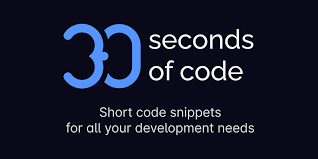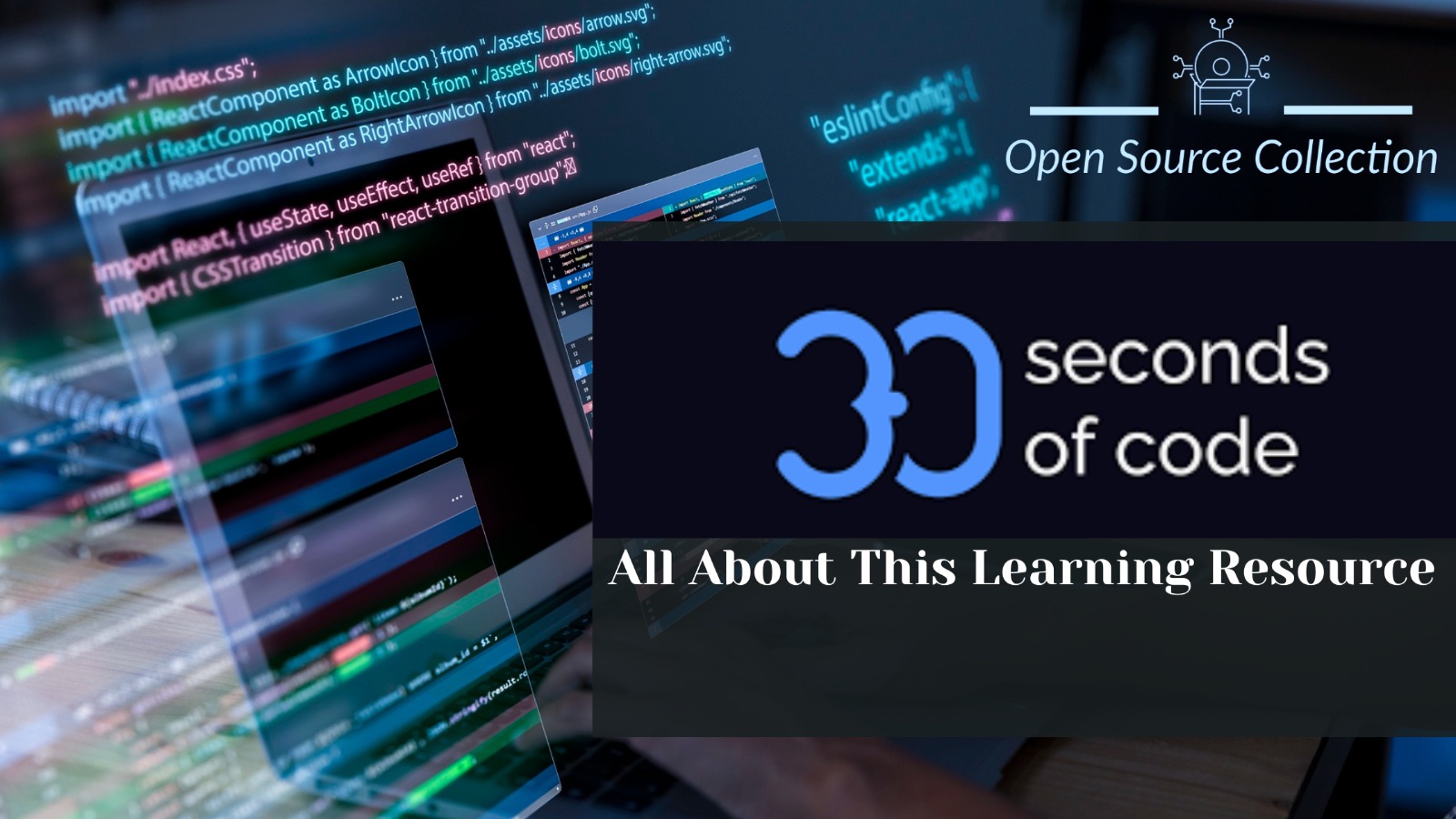Have you ever heard about “30 Seconds Of Code”? Wondering what it is? What are the benefits? Well, here you will get all your answers… So don’t skip in between because knowledge is key to success!
You know what? Since it began in 2017, 30 Seconds of Code has been offering top-notch learning materials for developers of any skill level. These materials come in the form of quick and easy-to-use snippets in different programming languages. So, let's find out more about “30 Seconds Of Code” here in this article.
30 Seconds Of Code- Overview
"30 Seconds of Code" is like a handy toolbox filled with short and simple pieces of code for different programming languages. These code snippets are made to quickly solve common programming problems in just 30 seconds or less. The whole idea is to make it easy for developers to find and use these quick solutions without having to write long and complicated code or spend a lot of time researching.

Since it started in 2017, 30 Seconds of Code has grown into a community with over 250 contributors and more than 10 maintainers. They're all working together to create easy-to-understand code snippets for developers of all skill levels. The goal is to make learning how to code easier and more accessible for everyone while supporting the open-source community.
Key features of "30 seconds of code"
Diverse Language Support:
The assortment includes programming languages, ensuring a wide variety of choices and accessibility for different audiences. It includes JavaScript, Python, PHP, Ruby, and other languages, and caters to a wide range of professionals with different language preferences and skills.
Categorized Snippets:
The code snippets are conceptually organized into specific groups, streamlining the process for developers to propose solutions as per their specific needs such as dealing with arrays, strings, functions, algorithms, and other domains. This organizing process improves the user experience better search and implementation.
Conciseness and Readability:
Each individual section of the code has been carefully crafted to be concise, easy to read, and self-contained. This deliberate choice of layout ensures that developers can quickly understand the functionality of each snippet and seamlessly integrate it into their projects. The emphasis on brevity and clarity not only facilitates understanding but also enables effective integration, enabling developers to effortlessly leverage these regulatory nuances to deliver their services.
Open Source and Community-Driven:
"30 Seconds of Code" is a great open-source project, encouraging developers to actively contribute their code snippets and improvements. Through this collaborative approach, the collection benefits from a constant flow of new ideas and developments. This active participation not only keeps the distribution up to date with the latest system developments but ensures continued relevance in the rapidly evolving software development landscape. The inclusive nature of this project invites a diverse community of developers to collectively shape and refine the codebase, fostering an environment of shared knowledge and innovation.
Educational Resources:
The project consistently incorporates comprehensive explanations, practical use cases, and illustrative examples alongside the code snippets. This educational dimension goes beyond just providing ready-to-use code; it encourages developers to delve into the underlying principles and comprehend how the code operates. By offering a deeper understanding of the code snippets, the project aims to empower developers to not only apply the code effectively but also to foster a robust comprehension of the underlying concepts. This emphasis on education promotes a holistic learning experience, enabling developers to grow their skills and make informed decisions in their coding endeavors.
Benefits Of Using 30 Seconds Of Code
Using "30 Seconds of Code" offers several benefits for developers:
Time Efficiency:
As the name suggests, the code snippets provided in this collection are designed to be concise and solve common problems quickly. Developers can save time by quickly finding and integrating these snippets rather than writing the code from scratch.
Learning Resources:
The snippets often come with explanations, use cases, and examples. This not only helps developers use the code but also aids in understanding the underlying concepts. It serves as an educational resource for both novice and experienced programmers.
Consistency and Best Practices:
The snippets in "30 Seconds of Code" are often crafted with attention to coding standards and best practices. Developers can benefit from using code that follows established conventions and guidelines, promoting consistency in their projects.
Community Collaboration:
The project is often open source, allowing developers to contribute their own snippets or improvements. This collaborative environment fosters community engagement and ensures that the collection stays relevant and up-to-date.
Versatility Across Languages:
The collection spans multiple programming languages, making it versatile for developers working with different technologies. Whether a project is in JavaScript, Python, Java, or another language, developers can find useful snippets.
Quick Problem Resolution:
Developers often encounter common problems that have well-established solutions. "30 Seconds of Code" serves as a go-to resource for quickly resolving these issues without the need for extensive research or trial-and-error.
Increased Productivity:
By leveraging the ready-to-use code snippets, developers can focus more on the unique and complex aspects of their projects. This can lead to increased productivity and faster development cycles.
Readable and Maintainable Code:
The snippets are designed to be concise and readable, promoting code that is easy to understand and maintain. This can be particularly beneficial when sharing code within a team or community.
Adoption of Best Practices:
Developers can learn and adopt best practices by studying the well-crafted snippets. This can be especially helpful for those who are relatively new to programming or a specific language.
Problem-Specific Solutions:
The snippets cover a wide range of categories, including arrays, strings, functions, algorithms, and more. This means developers can find problem-specific solutions without having to sift through extensive documentation or forums.
How to use their Code Snippets
Using a code snippet from "30 Seconds of Code" involves the following steps:
-
Selection: Choose a snippet from Snippet collections that addresses your specific programming task or challenge.
-
Copy: Copy the code snippet to your clipboard.
-
Paste: Paste the snippet into your code editor or integrated development environment (IDE) at the appropriate location in your project.
-
Adapt: If needed, make any necessary adjustments to integrate the snippet seamlessly with your existing code.
-
Run: Execute your code to see the snippet in action and observe the desired functionality.
Remember to check if there are accompanying explanations or use cases provided by "30 Seconds of Code" to better understand the snippet and how it fits into your project. Additionally, be aware of any dependencies or requirements mentioned in the snippet's documentation.
Wrapping up
30 seconds of code is a new concept for new learners but it is quite helpful for learners as well. Here we have provided you with a small vision of this amazing technology. Now you can use 30 seconds of code in your next project and these top-notch learning materials will make your work fast. So get your hands on this amazing pack of knowledge and make your coding journey easier… Happy Coding!
FAQs
Simply we can say that: "30 Seconds of Code" is a collection of quick and concise code snippets in various programming languages, designed to solve common tasks in 30 seconds or less.
A snippet of code is a small, isolated piece of programming code that typically performs a specific function or solves a particular problem.
To run a code snippet, you typically copy and paste the snippet into a code editor or an integrated development environment (IDE) compatible with the programming language used in the snippet. Then, execute the code within the environment to see the results.
To add a snippet, contribute to the project's codebase on platforms like GitHub by submitting your snippet along with any necessary explanations or examples.

